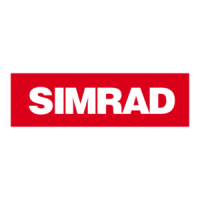Simrad ES60
8
857-160970 / Rev.H
Split-beam operation
The ES60 uses the split-beam technique for assessment of the
size distribution of individual fish. A split-beam transducer is
electrically divided into four quadrants. All four quadrants are
excited in parallel during transmission. However, the received
signal from each quadrant is separately amplified in a
four-channel matched receiver allowing the direction of arrival
of an echo to be determined.
Figure 3 Split-beam principles
An acoustic wave front propagating towards the transducer
arrives at the four quadrants at different times causing the phase
angle of the electrical output signal from the quadrants to differ.
The fore-and-aft angle is determined from the electrical phase
difference between the fore and the aft transducer halves, and
the athwartships angle is determined from the starboard and port
signals.
Fish A is positioned along the transducer axis where the
transducer has its maximum sensitivity, while Fish B is
positioned towards the edge of the beam where the sensitivity is
lower. Evidently, the echo signal from Fish A will be stronger
than the signal from Fish B even though they are of the same
size and at the same depth. Hence, determining fish size from

